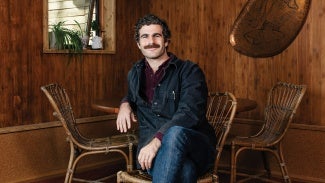
A kit of parts: Making bamboo architecture accessible
Jack Becker of bldus doesn't want to gatekeep his firm's sustainable practices.

Jack Becker, AIA, is a co-founder of bldus, a Washington, D.C.- based residential firm that focuses on new technologies and organic materials. We chatted with him about his family’s long history with architecture and his hopes for a more sustainable future for residential design.
During my undergraduate studies at Cornell, part of the freshman initiation involved a celebration called Dragon Day where students designed and fabricated a dragon. Andy [Linn, my current bldus partner,] and I were the vice presidents of Dragon Day, and we completed an entirely bamboo-based dragon that was basically like an exoskeleton of bamboo components. The dragon form was paraded around campus, and [the celebration] concluded with a bonfire. I think our undergrad experience instilled in us a certain attitude about materials, but it wasn’t until we started our own practice that we developed the ethos that we have [now] toward sustainability and materials.
In addition to my parents being architects who met in architecture school in the ’70s at Syracuse University, my great-grandfather and my grandfather on my dad’s side were both architects. All of them went to architecture school on the East Coast and practiced there. My great-grandfather was an architect of multifamily housing in New York and its boroughs, and then ultimately became the design deputy for the New York City Housing Authority. My grandfather was educated in New York and licensed to practice there, but after serving in World War II, he became active in the D.C. area. My grandfather mainly designed and built single-family suburban housing in Montgomery County, Md., and Arlington County, Va. My parents worked on single-family housing in the Chicago area.
The type of residential architecture that my family has pursued has changed over the years, but this country has also changed its priorities with respect to the type of housing that gets built, and where it gets built. I think my family’s generations of architects were more or less serving the prevailing demand and norms around housing—what’s desired by the public, where the energy is from a policy standpoint.
Our practice is in the middle of the city, so it’s a kind of return to my great-grandfather’s focus, which was urban housing and, specifically, accessible affordable housing—which, in his era, received more funding and emphasis. We try to involve ourselves in architecture that is healthy and accessible to as many people as possible. Some of that relies on public policy, but we’re looking to develop an attitude toward architecture and materials that becomes a kit of parts that’s accessible to the public and improves the standard for housing generally— not just for luxury housing.
I’m not interested in gatekeeping materials and systems like BamCore and sheep’s wool insulation. I think it would be wonderful if there was more widespread adoption of alternatives to mainstream construction conventions that predate the climate crisis, our current standards for energy efficiency, and our awareness of the environmental implications of materials that we’ve been using for centuries.
This article originally appeared in the December 2023 issue of ARCHITECT magazine.
